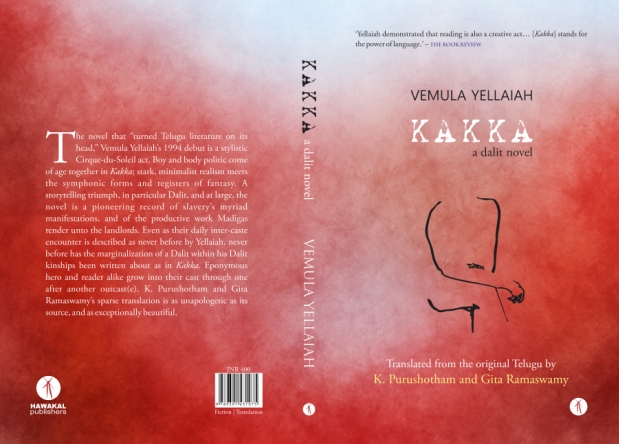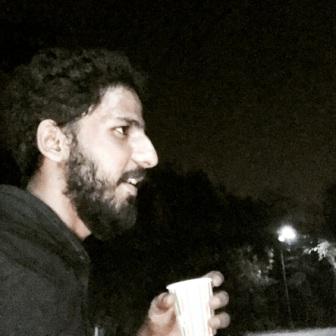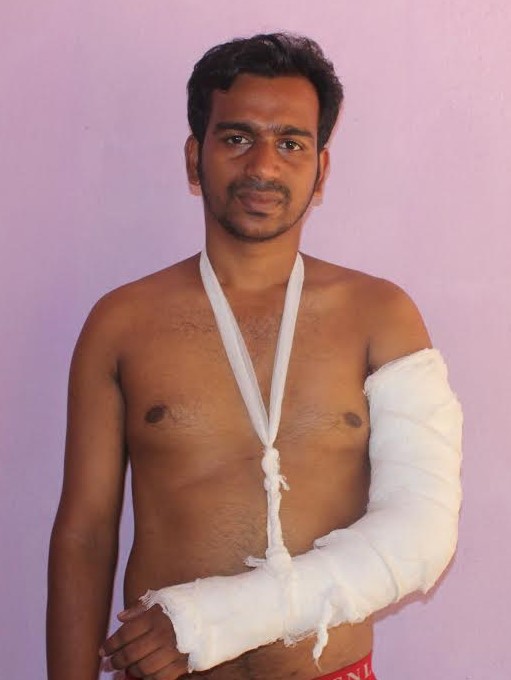Bhangya Bhukya
Vemula Yellaiah’s Kakka which was published in Telugu, twenty years ago and now translated in English is a powerful narrative of dalit assertion in Telangana. It is the first novel that ventilates Madiga life struggle closely. Somehow, it did not get its due recognition in Telugu literature as did G. Kalyana Rao’s Antarani Vasantham which was published in the same year – 2000. Of course, both novels were pitched in different social and political contexts.
Kakka tells the story of the Madigas whereas Antarani Vasantham tells story of Malas. Also, the author of Kakka comes from Ambedkarite politics and the latter one’s author comes from ultraleft politics. Thanks to K. Purushotham and Gita Ramaswamy, Kakka has got wider attention after they have introduced it to the English world. Indeed, their ‘Afterword’ at the end of the novel has contextualized it within the larger socio-political developments in the Telangana region.

The novel reflects the late twentieth century developments in Telangana, foregrounding the story of a Madiga widow and her son Kakka. Mother and son represent two important ideas of the novel. The novel can be divided into two parts in the backdrop of the two roles. In the first part, the mother represents the internal socio-cultural politics in the Madiga community, in the second part, the son represents caste politics in villages of Telangana. The author has crafted all the developments around these two roles very systematically.
The novel starts with a cattle festival, a spectacular event in Telangana villages at the beginning of the rainy season. Kakka makes preparations for the festival and decorates his landlord’s cattle. His father was a farmhand under the landlord and died of a scorpion sting before Kakka was born. When he grew up, his mother Kalemma puts him into jeetam (bonded labour) under Papi Reddy, a landlord in the village. Unbearable physical torture and harsh treatment at the hands of the patelamma, the landlord’s wife, is a regular affair for Kakka. Many a time Kakka refuses to work for the landlord but Kalemma convinces him, in the light of their family’s deplorable condition. Jeetam is one of the heinous practices in rural Telangana.
If a marginalised caste person joins a landlord under this contract, it is very difficult to come out of it, as the former takes some advances due to various family urgencies and social occasions. Repaying the advances is a big challenge and the contract continues to the next generation in many cases. If at all one wants to get relieved from the existing landlord, he has to borrow advance from another landlord and contract to work with him. This novel describes how this practice works. When Kakka is unable to bear the physical torture by Papi Reddy’s wife, he shifts to another landlord, Venkat Reddy.
The story shifts to the next level when Kakka’s mother Kalemma is accused of having sexual relations with Yellaiah, a generous Madiga who tries to help destitute families of the community. The author exposes the misconception of gender relations among the marginalised castes – they are often romanticized as an egalitarian society. The narration shows that dalit families are not free from Brahmanical patriarchal practices. Kalemma’s brother-in-law, Agamaiah tries to exploit her sexually. When she refuses, he accuses her of a relationship with Yellaiah and pulls her to the caste panchayat. Caste elders put Kalemma to severe tests and ultimately socially boycott her from the community. However, she stands strong and faces all the humiliations by the community. In a bid to overcome the trauma, Kakka gets her married to a widower.
After Kalemma is married, the plot turns to caste politics. Kakka’s marriage with Lasmakka provides the stage for these politics. When Kakka’s family goes to fetch anthill clay for the wedding decoration, the village landlords object. This creates tension between Dalits and landlords of the village. The landlords place restrictions on Madiga access to the village commons and public places. Interestingly, Isumiya, a Muslim, sides with the dalits and allows them to take clay from his land. The tension bursts into a violent clash when the bride and bridegroom are taken on a procession to the rachabanda – the village public place. The village patel instigates Shudra caste people against the Dalits. The Shudras hesitate to attack the Dalits but the patel’s provocative speech about the threats of any tolerance towards Dalits leads to clashes between the two groups. Dalits are beaten badly, and Kakka suffers severe injuries.
The village patel files a case in the police station against the Dalits. During enquiry it is found that the case was filed by Pakir-Thatha, grandfather of Lasmakka in his capacity as village head.The Madigas and villagers had not known till then that Pakir-Thatha was the village head. The village patel used to get Pakir-Thatha’s thumb impression every time on white paper and use it for all official purposes. Pakir-Thatha was told that all the thumb impressions were for the loans he had taken from the patel. Interestingly, a Shudra acts as deputy. The fraud is busted when the police sub-inspector comes in search for Pakir-Thatha. Dalits are arrested for attacking the villagers. Troubled by these incidents, Pakir-Thatha commits suicide.
After his death, the Madigas demand that the village headship should be given to Madigas as it is reserved for them. But the patel instigates the Shudras to claim the headship, citing the rule position that the deputy becomes the head. This fuels further tension between the Dalits and Shudras. The author explains systematically how reservation and modern politics are being exploited by the dominant castes in villages. It is a standard practice in Telangana and other parts of the country that whenever political positions are reserved for Scheduled Castes and Scheduled Tribes, the dominant caste picks up an innocent person from that community for the position. The actual candidate remains a symbol but the dominant caste person enjoys the real power of that position.
After the death of Pakir-Thatha, Kakka takes up the leadership of the Madigas and starts asserting their political and land rights. Interestingly, the cultural performances of the Madigas foreground these politics. The Madigas have a tradition of performing Jambavapuranam which narrates the origin of the Madigas. Kakka plays the role of Mahisasura in the play. He names his newly born child after Jambava. But on the day of the performance, Kakka is kidnapped by an unidentified person, (probably, the patel’s henchmen) and beaten up badly.
Indeed, the author shifts the plot from physical clashes to cultural politics through which the Madigas re-imagine their political and land rights. He celebrates madigirkam – the making of shoes for villagers and providing them leather implements for agriculture. Kakka is fascinated with madigirkam. The novel ends with the breaking of the rachabanda, which symbolizes the authority and dominations of the dominant caste in the village. There are many interesting and dense descriptions of dalit lives in the novel. Although it is creative writing, the novel helps us to understand what has been happening to Dalits in India after independence. It is a must read.
~~~
Bhangya Bhukya is a professor in University of Hyderabad










